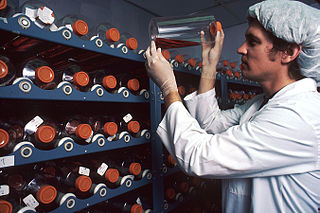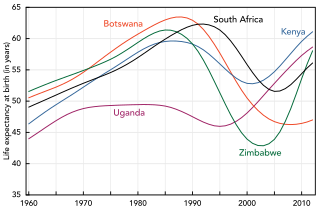
The economy of the Republic of the Congo is a mixture of subsistence hunting and agriculture, an industrial sector based largely on petroleum extraction and support services. Government spending is characterized by budget problems and overstaffing. Petroleum has supplanted forestry as the mainstay of the economy, providing a major share of government revenues and exports. Nowadays the Republic of the Congo is increasingly converting natural gas to electricity rather than burning it, greatly improving energy prospects.
In microeconomic theory, the opportunity cost of a choice is the value of the best alternative forgone where, given limited resources, a choice needs to be made between several mutually exclusive alternatives. Assuming the best choice is made, it is the "cost" incurred by not enjoying the benefit that would have been had by taking the second best available choice. The New Oxford American Dictionary defines it as "the loss of potential gain from other alternatives when one alternative is chosen." As a representation of the relationship between scarcity and choice, the objective of opportunity cost is to ensure efficient use of scarce resources. It incorporates all associated costs of a decision, both explicit and implicit. Thus, opportunity costs are not restricted to monetary or financial costs: the real cost of output forgone, lost time, pleasure, or any other benefit that provides utility should also be considered an opportunity cost.
Public capital is the aggregate body of government-owned assets that are used as a means for productivity. Such assets span a wide range including: large components such as highways, airports, roads, transit systems, and railways; local, municipal components such as public education, public hospitals, police and fire protection, prisons, and courts; and critical components including water and sewer systems, public electric and gas utilities, and telecommunications. Often, public capital is defined as government outlay, in terms of money, and as physical stock, in terms of infrastructure.

Research and development, is the set of innovative activities undertaken by corporations or governments in developing new services or products, and improving existing ones. Research and development constitutes the first stage of development of a potential new service or the production process.
The Australian Bureau of Agricultural and Resource Economics and Sciences (ABARES) is a federal research branch of the Australian Government Department of Agriculture, Water and the Environment, located in Canberra, Australia. ABARES was established on 21 August 1945 as the Bureau of Agricultural Economics (BAE), and is also involved in commercial consultancy. It was merged with the Bureau of Rural Sciences (BRS) in 2010. The main role of ABARES is to provide "professionally independent data, research, analysis and advice that informs public and private decisions affecting Australian agriculture, fisheries and forestry”. ABARES maintains the AgSurf database which includes farm survey data on farm performance, production benchmarks, farm management, socioeconomic indicators relating to the grains, beef, sheep and dairy industries in Australia. ABARES has received funding from business and industry groups. ABARES' website notes that "Over half of ABARES' external revenue is derived from commercial consulting work."

Government spending or expenditure includes all government consumption, investment, and transfer payments. In national income accounting, the acquisition by governments of goods and services for current use, to directly satisfy the individual or collective needs of the community, is classed as government final consumption expenditure. Government acquisition of goods and services intended to create future benefits, such as infrastructure investment or research spending, is classed as government investment. These two types of government spending, on final consumption and on gross capital formation, together constitute one of the major components of gross domestic product.
Research funding is a term generally covering any funding for scientific research, in the areas of natural science, technology, and social science. Different methods can be used to disburse funding, but the term often connotes funding obtained through a competitive process, in which potential research projects are evaluated and only the most promising receive funding. It is often measured via Gross domestic expenditure on R&D (GERD).

Science and technology in Brazil has entered the international arena in recent decades. The central agency for science and technology in Brazil is the Ministry of Science and Technology, which includes the CNPq and Finep. This ministry also has a direct supervision over the National Institute for Space Research, the National Institute of Amazonian Research, and the National Institute of Technology (Brazil). The ministry is also responsible for the Secretariat for Computer and Automation Policy, which is the successor of the SEI. The Ministry of Science and Technology, which the Sarney government created in March 1985, was headed initially by a person associated with the nationalist ideologies of the past. Although the new minister was able to raise the budget for the science and technology sector, he remained isolated within the government and had no influence on policy making for the economy.

Medical research, also known as experimental medicine, encompasses a wide array of research, extending from "basic research", – involving fundamental scientific principles that may apply to a preclinical understanding – to clinical research, which involves studies of people who may be subjects in clinical trials. Within this spectrum is applied research, or translational research, conducted to expand knowledge in the field of medicine.

In economics, the Baumol effect, also known as Baumol's cost disease, is the rise of wages in jobs that have experienced little or no increase in labor productivity in response to rising wages in other jobs that have experienced higher productivity growth. The phenomenon was described by William J. Baumol and William G. Bowen in the 1960s and is an example of cross elasticity of demand.

Research and development intensity is generally defined as expenditures by a firm on its research and development (R&D) divided by the firm's sales. There are two types of R&D intensity: direct and indirect. R&D intensity varies, in general, according to a firm's industry sector, product knowledge, manufacturing, and technology, and is a metric that can be used to gauge the level of a company's investment to spur innovation in and through basic and applied research. A further aim of R&D spending, ultimately, is to increase productivity as well as an organization's salable output.

HIV/AIDS affects economic growth by reducing the availability of human capital. Without proper prevention, nutrition, health care and medicine that is available in developing countries, large numbers of people are developing AIDS.
Knowledge spillover is an exchange of ideas among individuals. Knowledge spillover is usually replaced by terminations of technology spillover, R&D spillover and/or spillover (economics) when the concept is specific to technology management and innovation economics. In knowledge management economics, knowledge spillovers are non-rival knowledge market costs incurred by a party not agreeing to assume the costs that has a spillover effect of stimulating technological improvements in a neighbor through one's own innovation. Such innovations often come from specialization within an industry.
Mohammed Ishaq Nadiri is an Afghan American who is the Jay Gould Professor of Economics at New York University. A former department chair, he was also founder and first director of the C.V. Starr Center for Applied Economics. Professor Nadiri was a signatory of the 2001 Bonn meetings where the interim government of Afghanistan was created; a participant in the Tokyo meeting focused on funding Afghanistan’s reconstruction, the White House and UN Security Council meetings during Hamid Karzai’s visit in January 2002, and the Loya Jirga in Kabul in June 2002 that resulted in Mr. Karzai’s election as president. Nadiri served as Senior Economic Advisor to President Karzai. For his services and accomplishments, President Karzai awarded Nadiri with the Ghazi Amanullah Khan, the highest civilian award of Afghanistan.

Manufacturing is a vital economic sector in the United States. The United States is the world's third largest manufacturer with a record high real output in Q1 2018 of $2.00 trillion well above the 2007 peak before the Great Recession of $1.95 trillion. The U.S. manufacturing industry employed 12.35 million people in December 2016 and 12.56 million in December 2017, an increase of 207,000 or 1.7%. Though still a large part of the US economy, in Q1 2018 manufacturing contributed less to GDP than the 'Finance, insurance, real estate, rental, and leasing' sector, the 'Government' sector, or 'Professional and business services' sector.
The economics of science aims to understand the impact of science on the advance of technology, to explain the behavior of scientists, and to understand the efficiency or inefficiency of scientific institutions and science markets.
Genome Canada is a non-profit organization that aims to use genomics-based technologies to improve the lives of Canadians. It is funded by the Government of Canada. Genome Canada provides large-scale investments that develop new technologies, connect the public sector with private industry, and create solutions to problems of national interest, such as health, sustainable resources, the environment, and energy.
Science and technology in Kazakhstan – government policies to develop science, technology and innovation in Kazakhstan.

Lars-Hendrik Röller is a German economist who served as the Director General for Economic and Financial Policy at the German Chancellery from 2011 to 2022, a position that made him Chancellor Angela Merkel's chief economic advisor. He previously was the president of the European School of Management and Technology (ESMT) in Berlin. In 2002, he was awarded the Gossen Prize in recognition for his contributions to empirical industrial economics.

Science and technology in the Netherlands has an extended history, producing many notable achievements and discoveries in the field. It is an important component in the economic and societal development of the Netherlands. The Dutch government is a driver of scientific and technological progress with science expenditure passing €4.5 billion every year.











